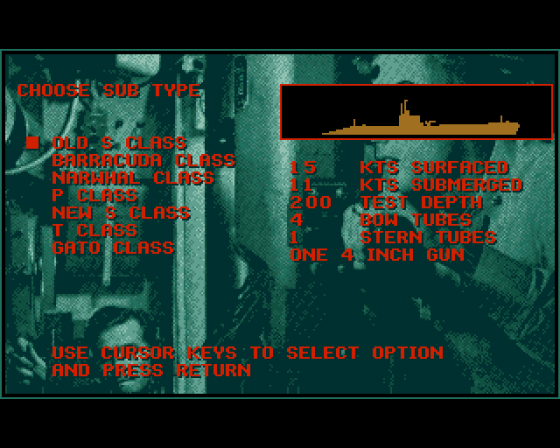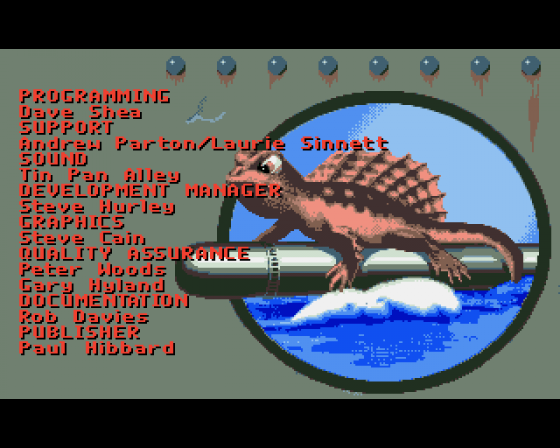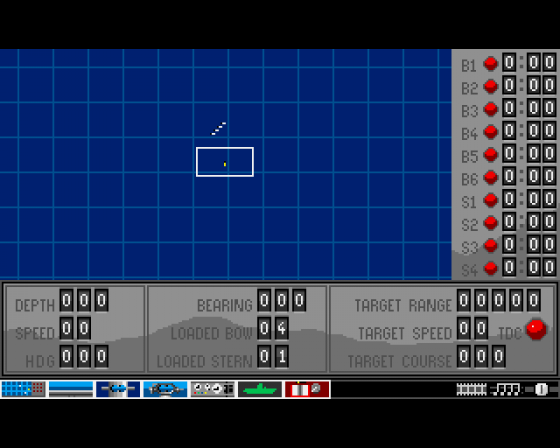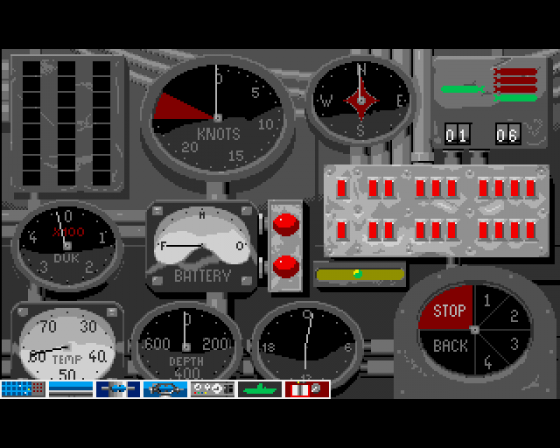
The One
 1st October 1991
1st October 1991
Categories: Review: Software
Author: Laurence Scotford
Publisher: Microprose
Machine: Amiga 500
Published in The One #37
Laurence Scotford dives into the sequel to MicroProse's classic submarine simulator and blows all his tanks over it.
Silent Service II (Microprose)
"Enemy ships at 240 degrees, Sir, range - 10,000 feet!" It's 1944, the war in the Pacific is at its height and it's your first time out as a US Navy submarine commander. It could also be your last. On a routine patrol you've come across a Japanese Carrier Group. They haven't spotted you, but if they do you're in trouble: they've got a lot more firepower than you and they're faster.
What do you do? Do you attempt to pick off one or two ships and then make an escape? Do you make a brave stand against the whole group? Or do you dive to escape sonar and radar detection and slip silently away? Those are exactly the sort of decisions you will have to make continually in Silent Service II, the sequel to the classic submarine sim. Silent Service wasn't short of atmosphere, but its younger brother makes use of the Amiga's advanced features to enhance this even further.
Silent Service II doesn't emulate the all-singing all-dancing modern submarines seen in films such as The Hunt For Red October, but the less sophisticated submarines that helped America to win the war in the Pacific in World War II. These are boats with a test depth of no more than 400 feet and a maximum speed of 20 knots. Furthermore, World War II submarine commanders were forced to work with primitive analogue targeting computers and frequently faulty torpedoes.

Unlike MicroProse's aircraft simulations, where the main requirement is careful planning backed up by lightning reactions, commanding a submarine calls for even more meticulous planning, continual strategic decisions, and a lot of patience. If you get caught by a Japanese ASW (Anti-Submarine Warfare) ships you may have to stay submerged for some time during which you dare not proceed at more than a crawl for fear of triggering a potentially fatal depth charge attack.
Silent Service II offers a wide range of playing options ranging from a series of single battles, based on historical encounters, through to a complete war career. Additionally, there are four levels ranging from Introductory, where the enemy is stupid and you get a ridiculously high percentage of hits, through to Ultimate, in which you've scarcely left port before your dogged by ASW ships.
As well as adjusting the difficulty level, you're also free to choose between historical or flawless torpedoes. Go for the accurate option and you'll find many of your shots prematurely exploding or failing to go off at all, which can be frustrating if the target escapes as a result.
The Verdict

Like most prolific publishers, MicroProse has released some dud software in its time, but it really can't be faulted on the quality of its simulations - and this is one of the best yet. If you are prepared to take some time with this game, I guarantee you'll be hooked within the first few hours of play.
The presentation of the product throughout is superb, with highly realistic views through the periscope and from the bridge and atmospheric sound effects. The superb soundtrack even makes up for the tedious loading time. The documentation is up to the usual excellent MicroProse standard and includes two detailed tutorial sections, backed up by a simple tutorial game on the disk.
This should be enough to acquaint even the slowest players sufficiently well with the controls to undertake a real mission. Parts of the submarine's controls can be operated with the joystick or mouse, but I suspect that most players will prefer to stick to the keyboard, which is by far the easiest way of controlling the game. The variety of difficulty settings, the choice of historical or flawless torpedoes, and the ability to play short games or a whole campaign mean that Silent Service II caters effectively for a wide range of players, and will prevent the game's appeal from palling to quickly.
If you get too good, you can always try to play again with an old 'S class' submarine, which should be enough to challenge anybody. If you have some patience and enjoy in-depth games then try this: you'll be hard-pressed to find an experience as long-lasting and engrossing as this one.
Other Reviews Of Silent Service II For The Amiga 500
Silent Service II (MicroProse)
It may not be everyone's cup of tea - heavy duty military simulations of this sort never are - but with the original Silent Service selling half a million worldwide, it's unlikely MicroProse are going to find themselves out of their depth with this one. (And - would you believe it? - it's fun too!)
Silent Service II (Microprose)
A review










